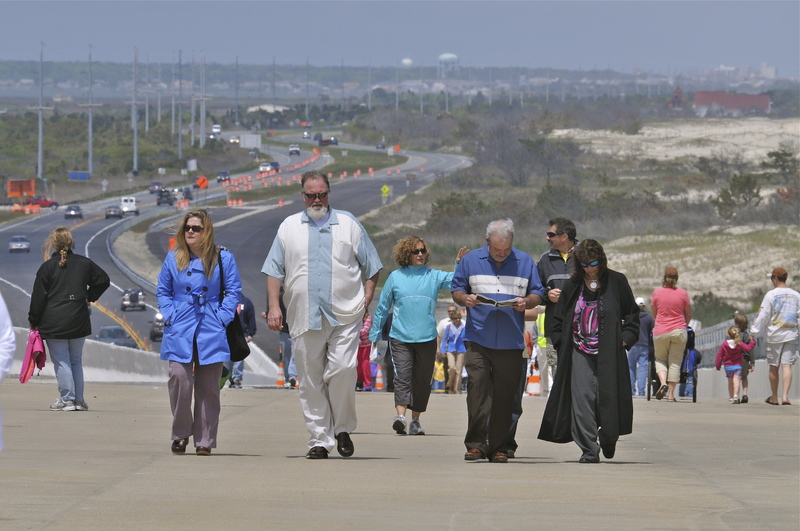More than 2,000 people took a stroll over the new Indian River Inlet bridge May 6, as officials dedicated the $150 million span for the fourth time to Charles W. Cullen.
The bridge will not be open to all four lanes of traffic for another three weeks, Delaware Department of Transportation officials said.
The two unfinished lanes and the pedestrian/bicycle lane were open to walkers and bikers from 10 a.m. to 4 p.m. A U.S. Coast Guard cutter and the Lewes Fire Department fire boat were on hand for the dedication. Officials gathered in the middle of the bridge atop a DelDOT truck during the ceremony.
“The bridge will be an economic driver for years to come,” said Gov. Jack Markell, adding 60 Delaware companies were involved with the project. “The most important responsibility we have is the investment we make for those who come long after we are all gone. Thank you for investing in the Delaware of today and 50 and 100 years from now.”
Markell thanked Delaware's congressional delegation for securing 60 percent of the funding for the project.
DelDOT Secretary Shailen Bhatt said there were some challenges getting to this point, but thanks to bridge builder Skanska and dedicated DelDOT staff, a legacy has been established.
A time capsule to be opened in 2062 containing construction materials and signatures of school children who toured the site has been placed in the State Archives.
Cullen, who was born in 1865 in Georgetown, was a prominent lawyer who was on the staff of Delaware Gov. Robert Reynolds and also served on the board of the State Highway Commission from 1930 to 1940. While he was serving as chairman of the committee, a new bridge was built over the inlet to replace a deteriorated wooden bridge built there in 1934. It was the first of five bridges - including the newest one - over the inlet. The second bridge was opened in 1938. This is the fourth bridge over the inlet named in Cullen's honor.
|
BRIDGE BITS Concrete used: 28,000 cubic yards Rebar used: 8.8 million pounds Number of concrete pilings: 288 Pylon height: 247 feet Span over water: 950 feet Clearance for boats: 45 feet Roadway: In each direction there are two 12-foot-wide travel lanes, a 10-foot-wide outside shoulder and 4-foot-wide inside shoulder. A 12-foot-wide sidewalk can be accessed from the ocean side of the bridge. |
U.S. Sen. Tom Carper joked he was waiting for the bungee jump to start. He said the coastal area is blessed with clean beaches - Rehoboth Beach and Dewey Beach are among the few Five Star beaches on the East Coast, and Bethany Beach was recently named one of the best kept secrets in the world. “But people need to get here, and now we have a bridge that provides a safe way for travel,” he said. “Delaware is the complete package, and someday soon visitors can visit a new national park.”
Sen. George Bunting, D-Bethany Beach, who drives over the bridge to his insurance agency in Rehoboth Beach each day, said getting a new bridge built became one of his top priorities 15 years ago.
“Thank you for helping this retiring senator's dream finally come true,” he said.
Rep. Gerald Hocker, R-Ocean View, also has a strong connection to the Indian River Inlet bridge - he had two grandfathers who served as bridge tenders when the span was a drawbridge. That bridge was destroyed by ice during a nor'easter, and four people were killed.
Other bridges were constructed in 1952 and 1965. The 1952 bridge was also destroyed. The 1965 bridge - which was widened in 1976 - was built on concrete piers supported by steel pilings in the inlet. Over the years, strong currents continuously scouring the inlet channel bed created holes 100 feet deep around the pilings.
Mobilization for the fifth bridge began during the winter of 2008, and the first two lanes were open to traffic in January.

























































